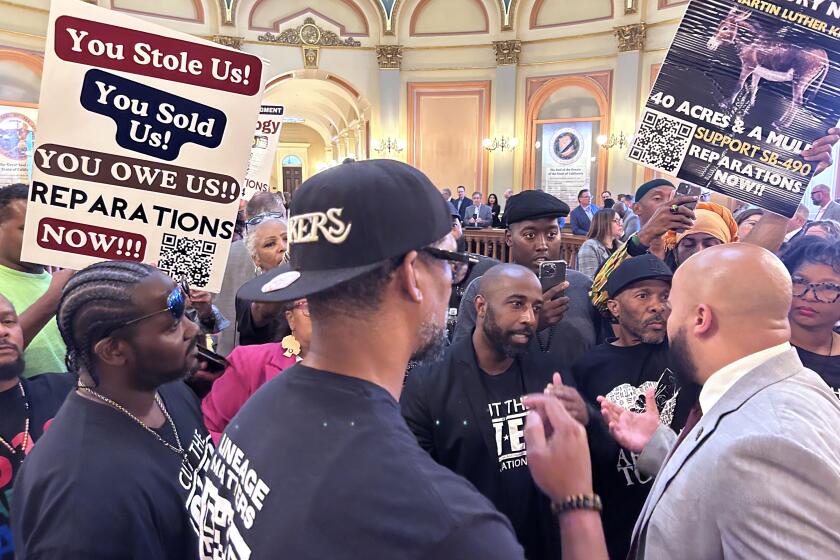Anti-gang plan faces key hurdles
- Share via
The proposed push to attack Los Angeles gang crime seems straightforward enough: increase the police presence, broaden gang injunctions, start issuing “stay away” orders for hot spots and target the city’s top 10 havoc-wreaking gangs.
But even as the plans are being drawn up, there are significant questions about whether the police personnel, jail beds and gang intervention programs exist to back up the effort, prompted by a 14% increase in gang-related crime.
Los Angeles Police Department officials said last week that finding enough street officers to make a difference in the hardest-hit communities may prove hard. Although the LAPD has the money to make more hires, the department fell 300 officers short of its hiring goal last year.
“That is the big question: Where will we get the officers?” said Deputy Chief Charlie Beck, who was promoted to head the South Bureau last year after working as the second-in-command of LAPD operations.
“We’re going to have to pull people from everywhere: patrol, traffic.... We’ve kept general crime way down, but gang crime has bubbled up, so we’re changing focus,” Beck said. “We are inevitably robbing Peter to pay Paul.”
In the San Fernando Valley, where gang-related crimes surged 42% last year, LAPD sources said the department is preparing to shift dozens of officers into problem neighborhoods.
Expanding such efforts into other gang-infested areas is likely to require significantly more officers.
Chief William J. Bratton said he and the mayor intend to unveil a plan in two weeks to better use the department’s current 9,400 uniformed officers to fight gangs. Bratton did not give specifics, but his top aides say patrol officers will be directed to take a more active role in gang suppression and intelligence gathering, expanding responsibility for duties traditionally handled by gang units.
Also under consideration is the deployment of strike forces to crime hot spots. Last year a similar approach used officers fresh from their first year of training to increase enforcement on skid row.
As the department struggles to hire about 1,000 additional officers whose positions are budgeted, Bratton said he supports a proposal by some City Council members to temporarily use money set aside for new hires to fund more overtime for existing officers.
Another pressing issue is what will happen to gang members after they are sentenced and enter the overcrowded county jail system.
The county jails have released more than 200,000 inmates early, most serving just 10% of their time, since mid-2002, when Sheriff Lee Baca stopped using thousands of jail beds amid budget shortfalls.
But inmates convicted under gang injunctions have been kept for their entire sentences. That policy, however, is set to end soon. Instead of doing all their time, gang-injunction convicts will be let go after serving 25% of their terms in an across-the-board release policy that will govern all inmates sentenced in the county courts. The shift is part of an agreement reached late last year after county prosecutors expressed concerns about unequal treatment of inmates.
Los Angeles City Atty. Rocky Delgadillo said last week that the policy change will “take the teeth out” of the city’s 32 gang injunctions, which cover more than 40 gangs and 60 square miles of the city.
“We objected,” Delgadillo said of the early-release plan for those under gang injunctions. “I’m very disappointed, because of the increased threat that this policy change will create for city residents. I think this sends the wrong message at the wrong time, and I strongly encourage the sheriff to reconsider.”
Baca said that if he had the jail beds, he would hold all gang members for their entire sentences.
“Rocky knows better than to throw a cheap shot over my way when he knows full well it was county and city prosecutors who asked me to do this,” the sheriff said.
Baca added that he agreed to shift to a uniform release policy, which will increase the portion of sentences served by most inmates, only after prosecutors brought concerns to him.
He said he would be willing to reconsider the early release of gang injunction convicts, who in Los Angeles number 300 to 400 a year, if advised by Los Angeles County Dist. Atty. Steve Cooley and Delgadillo that doing so would be appropriate.
“I am not intransigent on something this important,” Baca said.
Despite the constraints of the city’s and county’s criminal justice resources, as top officials work on a plan to address long-entrenched gangs, they say they believe they can do more with existing assets.
Assistant Chief Earl Paysinger said the department must get all street officers involved in gathering gang intelligence and in combating gang activity. The LAPD currently has about 300 officers who specialize in gangs. The city has about 39,000 gang members, according to police estimates.
“We are going to make sure all patrol forces understand gang behavior, trends and activity,” Paysinger said. “We have to work smarter.”
At the neighborhood level, he said, police need to track juvenile gang offenders through the system and be alert when they are about to be released.
“We need to sit down with that lad and warn him and his mother: If you re-offend, we’ll go after you with everything we’ve got,” Paysinger said.
Bratton, Baca and other top officials say they are well aware that prevention and intervention must be key elements of any battle against gangs.
Unclear is what role, if any, may be proposed for community activists who in the past have helped negotiate truces between warring gangs.
City leaders plan to look to a report released Friday by civil rights attorney Connie Rice for guidance in creating more effective community outreach.
Rice, who is leading an anti-gang task force at the request of the City Council, proposed a large-scale initiative to provide young people with jobs and other alternatives in gang-plagued communities. She also called for one central agency to be in charge of the city’s nearly two dozen anti-gang programs.
Last year Rice’s nonprofit organization issued a bleak analysis of the results being produced by those programs. Despite the city’s expenditure of $82 million a year, the report found little coordination of the efforts and said most city-funded programs could show no evidence that their work made any difference.
*
(BEGIN TEXT OF INFOBOX)
Los Angeles gang injunctions
These gangs are currently subject to injunctions restricting their members’ activities in specific geographic areas of the city.
LAPD Valley Bureau
Blythe St.
Canoga Park Alabama
Langdon St.
Pacoima Project Boys
---
West Bureau
Black P Stone
Culver City Boys
Greer St. Crips
Hollywood 18th St.
Mara Salvatrucha
School Yard Crips
Venice 13
Venice Shoreline Crips
Wilshire 18th St.
---
Central Bureau
18th St.
18th St. Pico Union
38th St.
42nd St. Crips
Avenues
Big Hazard
Clover
Crazy Riders
Dogtown
Down in Action
Eastlake
Highland Park
KAM
Krazy Town
La Raza Loca
Lincoln Heights
Mara Salvatrucha
Orphans
Playboys
Rockwood St. Locos
Varrio Nuevo Estrada
Varrio Vista Rifa
Wanderers
White Fence
Witmer St. Locos
---
South Bureau
18th St.
Black P Stone
Bounty Hunters
Eastside Wilmas
Grape St. Crips
Greer St. Crips
Harbor City Boys
Harbor City Crips
Harp
---
Sources: L.A. city attorney’s office, LAPD
More to Read
Sign up for Essential California
The most important California stories and recommendations in your inbox every morning.
You may occasionally receive promotional content from the Los Angeles Times.












